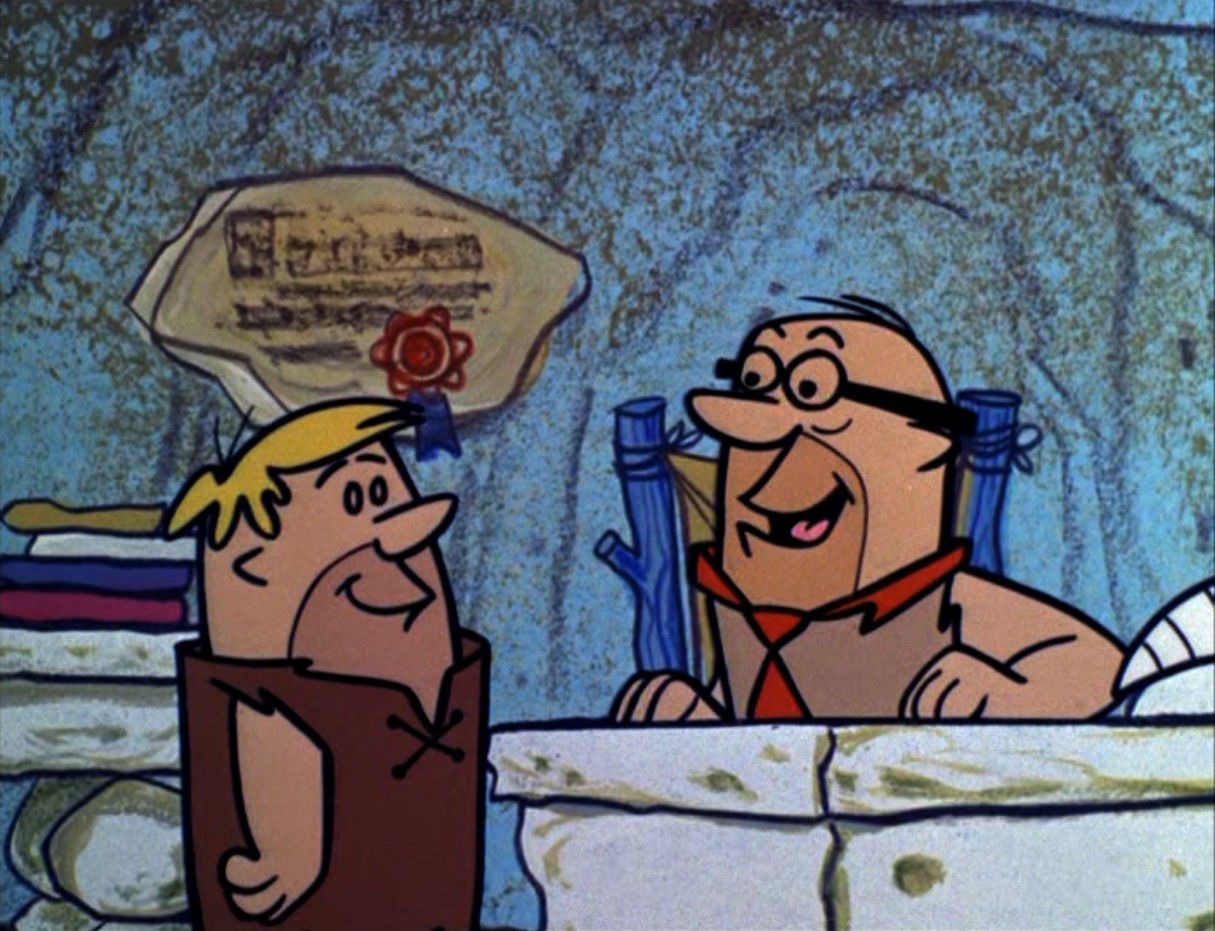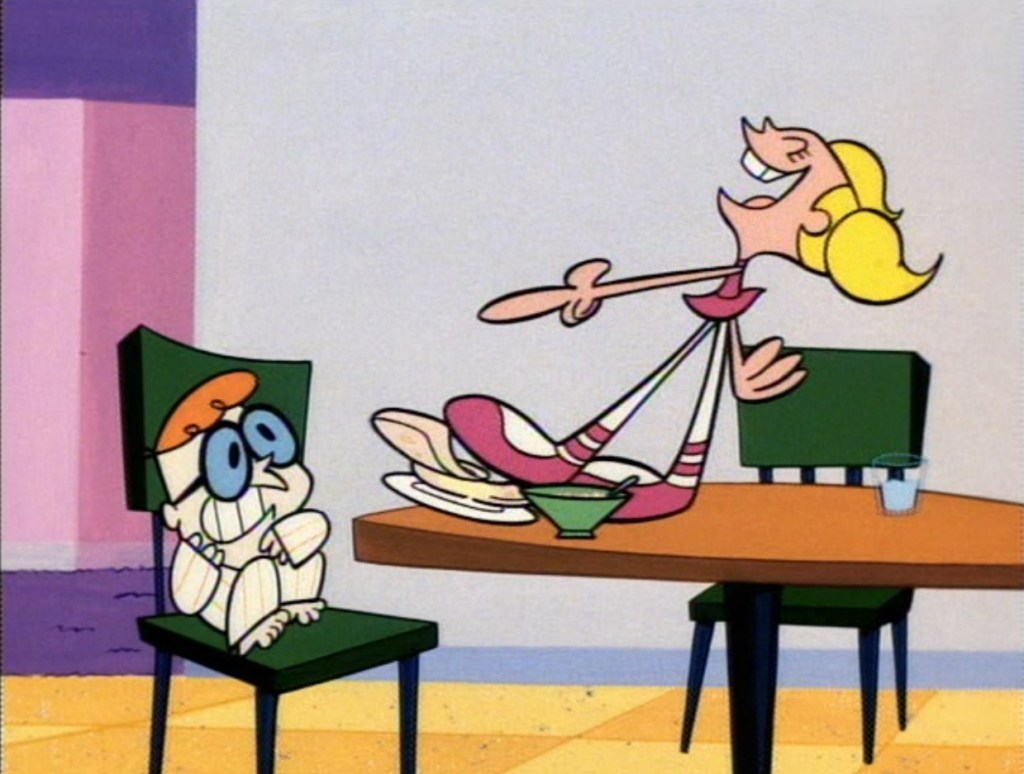You are currently browsing the category archive for the ‘★★½’ category.
Director: Karey Kickpatrick
Release date: September 28, 2018
Rating: ★★½
Review:
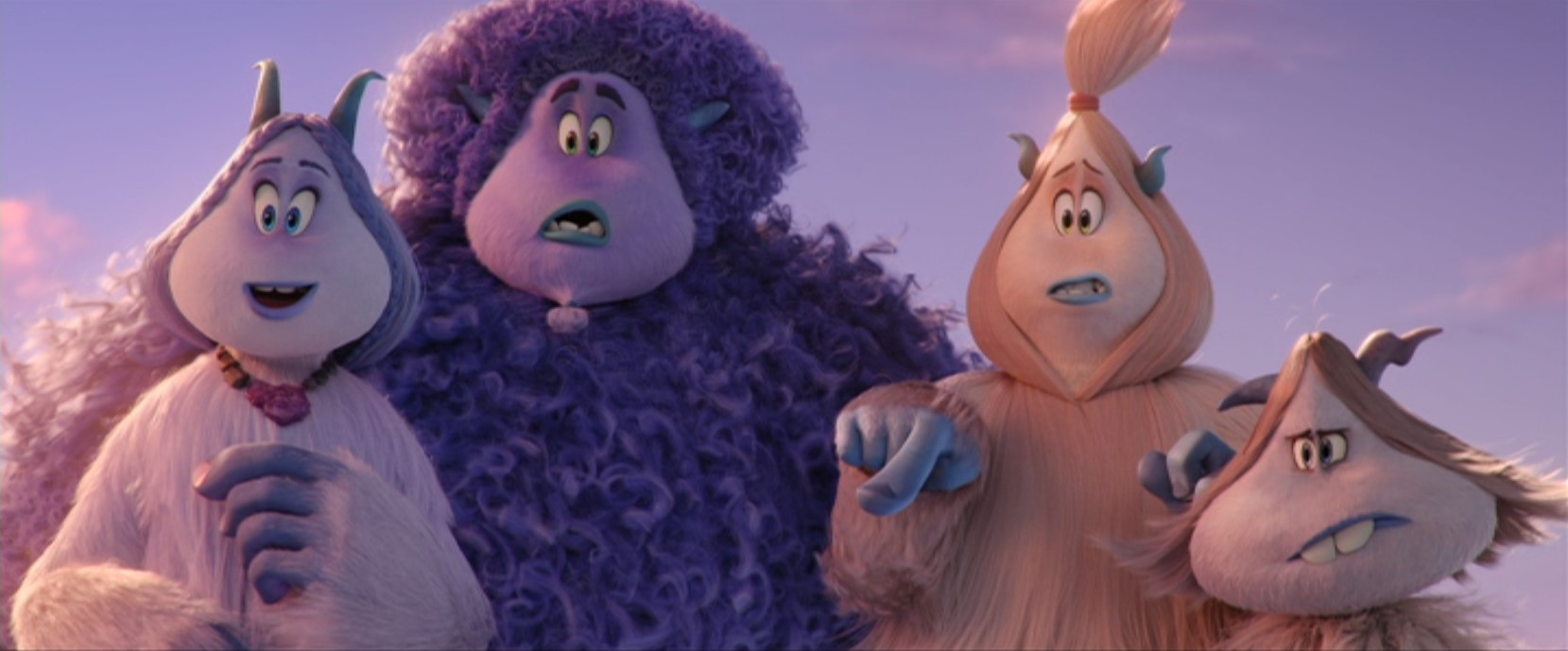
In the strange world of American computer animated feature films, movies with the same story subjects are released at the same time. This phenomenon was particularly striking in the industry’s earliest years, but in 2018-2019 it struck again. This was apparently the year of yetis, with Warner Bros.’ releasing ‘Smallfoot’ in September 2018, Laika ‘Missing Link’ in April and Dreamworks ‘Abominable’ in September 2019.
Of these three ‘Smallfoot’ was thus released first. The film was made by Warner Bros. Pictures Animation, a rather late addition to the American computer animation studio scene, debuting in 2014 with the excellent ‘The Lego Movie’. Since then, the studio has failed to get its own signature (the Lego movies are like a brand of their own, feeling more like Lego movies than Warner Bros. ones), and ‘Smallfoot’ certainly does nothing to change that.
In fact, animation, design, story, and style are all so incredibly generic the film could have been made by any studio save Walt Disney and Pixar, the only studios with a distinct style. The only surprise element of ‘Smallfoot’ is the fact that it’s a musical. And although I’m no musical fan, I must say the songs are rather good. Even better, ‘Smallfoot’ is the first musical with a genuine hip hop number, with alternative rapper Common voicing the Stonekeeper (rappers had voiced animation characters before, like Tone-Lōc voicing the goanna in ‘FernGully: The Last Rainforest’ (1992), but he doesn’t rap there).
‘Smallfoot’ starts with the voice-over of Migo (Channing Tatum), a cheerful young yeti introducing his own village and its rather silly mythology. Immediately thereafter Migo sings a happy song about how perfect his world is, and we know for sure that this character is set up for a major disappointment. And indeed, when Migo is accidentally catapulted outside the village, he sees a supposedly mythical ‘smallfoot’ (a.k.a. human) and from then his world view starts to tilt.
Interestingly, the naive Migo is joined by a group of dissidents, led by a young female yeti called Meechee (voiced by Zendaia), who’s way ahead of our hero. Meechee is such an independent, curious and powerful character that when Meechee sings ‘Wonderful Life’ to Migo this is practically ‘A Whole New World’ from ‘Aladdin’ in reverse. In fact, Meechee is a much more interesting character than Migo and it’s a pity ‘Smallfoot’ isn’t her film.
The third main character is Percy Patterson, a film maker of wildlife documentaries, who apparently has reached a low point in his career. Of all the film’s characters Percy is the most annoying and the least developed. Percy’s story arc is very poor: he remains such a jerk in most of his scenes that his final redemption is utterly unbelievable. Likewise, how Percy manages altitude sickness is beyond any believability.
Unfortunately, Migo’s progress also pushes boundaries of believability. As the filmmakers seem willing to tick all the familiar boxes, Migo undergoes the obligatory breakup scene – but this is an extreme one, with Migo denying his friends and his own views in public. We know why he does it, but the motivation is in fact rather weak, and it’s an enormous breach of character. Likewise, the following reconciliation feels forced and way too easy, given this severe betrayal. And don’t start me on the glorious rainbow finale that defies all we had learned before.
‘Smallfoot’ has a strong message that one should not believe everything, but that one should investigate oneself. But the film also features a ‘deep state’ or ‘fake news’-scheme of epic proportions, so the message is a rather confusing one. If anything, I’d say the film is anti-religion, but I wonder if that is according to the film makers’ intentions.
No, apart from the songs the film’s power is in its humor. Despite all its flaws and cliches ‘Smallfoot’ is an entertaining and funny film. The roasting scene is a particular highlight in that respect. I also like the idea that humans and yetis can’t understand each other at all, and their voices mutually sound like puny squeeks and fearsome growls, respectively. So the film is not a drag, on the contrary. Nevertheless, to carve out its own niche in the crowded feature animation world, Warner Bros. animation certainly will have to do better.
Watch the trailer for ‘Smallfoot’ yourself and tell me what you think:
‘Smallfoot’ is available on Blu-Ray and DVD
Director: Kitaro Kosaka
Release date: June 11, 2018
Rating: ★★½
Review:
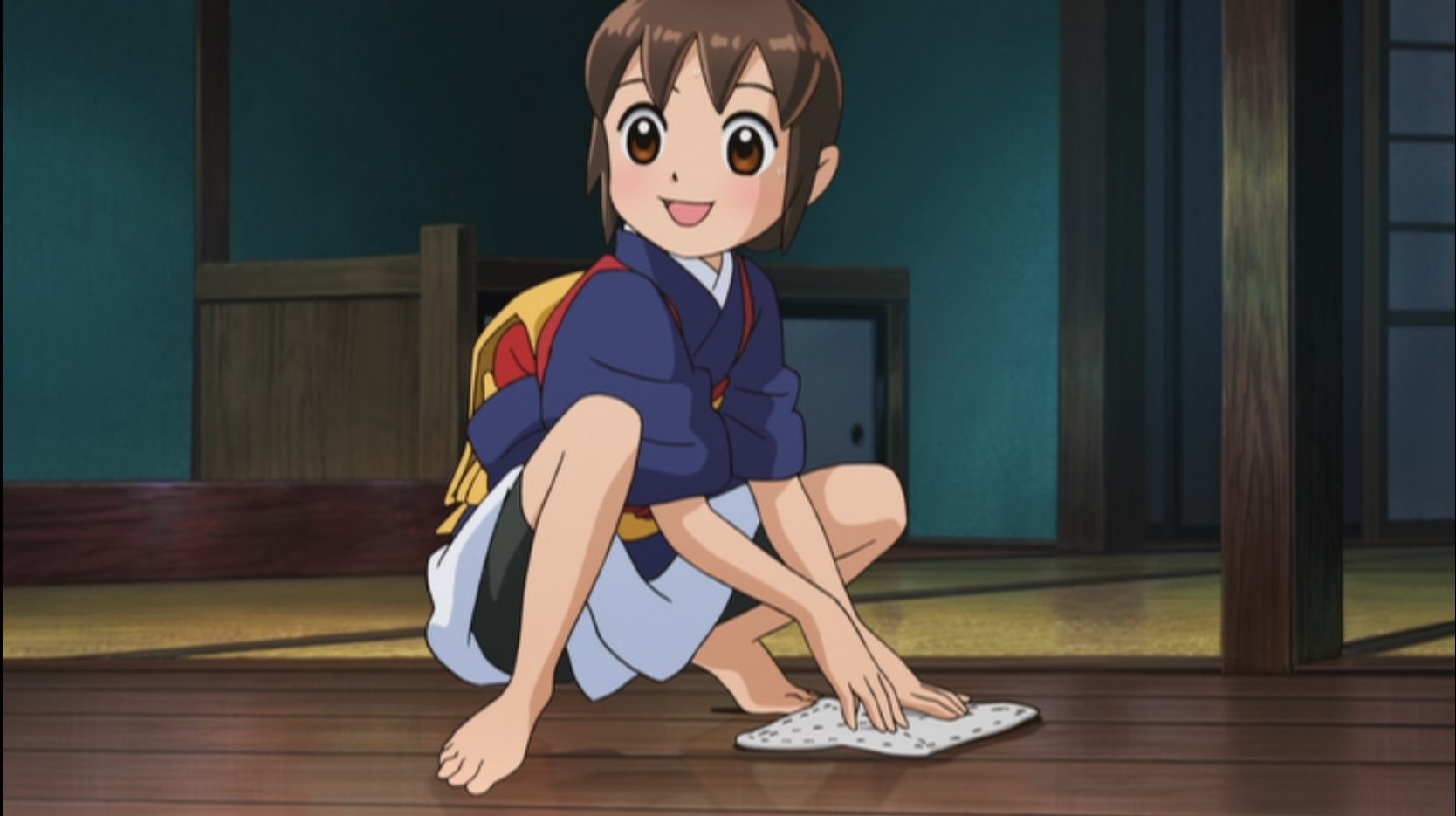
‘Okko’s Inn’ is an animated feature film by Madhouse based on a children’s novel series Hiroko Reijō. The film stars a little girl, who’s still at elementary school when she survives a terrible car accident in which her parents die. After this tragic incident she goes to live with her grandmother, who runs a ryokan, a traditional inn in a spa town near Mount Ikoma, East of Osaka, where she meets some ghost children and even a boyish demon.
Okko is supposed to help at the inn, and naturally we watch her grow into her new life and role, helped by the ghost children and little demon, whom we learn more about on the way, while Okko must deal with a girl whose family runs a larger rival inn.
The movie thus taps from familiar tropes in Japanese animation, like a girl losing her parents, and having to work, and the glories of traditional rural Japan as opposed to modern city life. The movie thus at times is reminiscent of such masterworks as ‘Spirited Away’ (2001) or ‘A Letter to Momo’ (2011). In content that is, for stylistically ‘Okko’s Inn’ is very poor. The designs are the most generic possible, with Okko herself being a particularly standard wide-eyed manga girl, and the animation is only fair. Moreover, the film lacks the subtleties of its peers. The film almost mechanically goes through the motions, as if ticking the necessary boxes, and the narrative lacks the surprising twists and turns of aforementioned examples.
It doesn’t help that the film’s message is partly told through guests of the inn, whose role seems almost to help Okko further in life. There’s a father with a son, whom Okko helps through their grief, and there’s an independent woman, a fortune teller, who befriends Okko and helps her getting more self-confident. And then there’s a third family staying, containing the biggest surprise of all.
The biggest flaw, however, is that we don’t see anything of Okko’s grief at all until the very end of the movie. Most of the time we don’t feel her trauma, we don’t feel her fear and we don’t feel any sense of readjustment. We see some of it, but we don’t feel it: in fact, Okko grows surprisingly easily into her new role. Nevertheless, there’s a scene in which Okko meets her anxieties, and this is by far the emotional highlight of the movie. Unfortunately, this powerful scene is followed by a mindless one on shopping.
‘Okko’s Inn’ is not a bad movie, but it’s not a stand-out either, and the film feels as a poor man’s version of ‘Spirited Away’. If anything, the feature shows that also the Japanese animation industry can pour out films that feel like run-of-the-mill products.
Watch the trailer for ‘Okko’s Inn’ yourself and tell me what you think:
‘Okko’s Inn’ is available on DVD and Blu-Ray
Director: Eiichi Yamamoto
Release date: September 15, 1970
Rating: ★★½
Review:

The most important development in animation of the late 1960s and 1970s was the coming of animated feature films aimed at adults, instead of children/families. Heralding the new era was George Dunning’s 1968 film ‘Yellow Submarine’, but the two most important film makers pioneering in this new field were Ralph Bakshi in America (with e.g., ‘Fritz the Cat’ from 1972 and ‘Heavy Traffic’ from 1973) and Osamu Tezuka in Japan.
The three adult oriented anime films Tezuka made at his own Mushi Productions studio are called the Animerama trilogy and consist of ‘A Thousand and One Nights’ (1969), ‘Cleopatra’ (1970) and ‘Belladonna of Sadness’ (1973). The three show that Tezuka, like Bakshi, confuses adult oriented with a rather juvenile focus on sex and violence, making the films adult in content indeed, but otherwise rather immature and even exploitative products.
More than its adult orientation, ‘Cleopatra’ stands out for its highly eclectic style. The film tackles a variety of designs and animation styles, none weirder than the opening sequence, which takes place in the future year of 2001, and which starts live action actors with animated faces, an experiment luckily not repeated, for the results are pretty ridiculous, especially because there’s absolutely no lip synchronization, at all.
The film’s plot revolves around an alien planet called Pasatorine, which has a secret plan to wipe out mankind called ‘Cleopatra’. In order to find out the plans a trio of humans, naturally, goes back into time by “psycho-teleportation”, taking the souls of ancient characters in Cleopatra’s time.
Thus, the three main protagonists change identity: Jirov becomes Ionius, a powerful slave, Maria becomes Libya, an Egyptian city girl, and Hal turns into Lupa, a close companion of Cleopatra, who turns out to be a leopard, much to Hal’s chagrin. His character is the most annoying of the film, for the leopard is sex crazed and tries to get laid all the time, despite its animal features.
After ten minutes we’re in Egypt where Tezaku depicts the Roman conquest of the ancient kingdom in a very silly style, accompanied by some attractive space funk music. When we first see Libya, the adult orientation immediately becomes clear, for she’s bare breasted the whole time. The Egyptian plot is bizarre, too, with an ugly freckled girl changing into the sex goddess of Cleopatra with the sole reason to seduce Caesar and to kill him. Adding to the weirdness is the coloring, for Libya is rendered bright red, while Caesar is depicted as a green man.
Stylistically, the film is all over the place, anyhow, altering tiresome silliness and cheap rotoscoping with quite some beautiful graphic imagery, like the stylized fighting of the Romans and the Egyptian conspirators. The animation, too, is a mixed bag, from non-animation and cheating jump takes from pose to pose, without any animation in between, to far more interesting animation done in watercolors. The animation of the horse ride, and the struggle between Ionius and an Egyptian warrior are actually quite good, and even the first two sex scenes are interesting in their semi-abstract and even poetical stylization, while the third is depicted as a broken-down film. At one point the imagery reminds one of UPA or the Zagreb school, and at another point there’s even a cut-out sequence featuring variations on classic paintings.
What the film completely lacks, is character animation. Emotions are just indicated, not felt, and there’s only broad caricature, not character development. The potentially dramatic story is further hampered by random gags, often strange and out of place. Likewise, the story is sloppy and meandering, with the film makers having difficulty on whom to focus. For great chunks of screen time, the three protagonists from the opening sequence aren’t anywhere to be seen, and after the events in ancient Egypt have ended tragically (in that respect the film does follow Cleopatra’s real life), the film ends abruptly, leaving the viewer wondering why the whole ‘psycho-teleportic’ excursion, and thus most of the movie, was needed in the first place.
It must be said: ‘Cleopatra’ is not a good movie. It is more of an experiment than a success, more of a product of its time than a timeless movie, and rather a curio than an essential watch. It is a product of a more experimental era, but after watching the film, one can hardly wonder why this short age of adult oriented experimentalism stopped.
Watch the trailer for ‘Cleopatra’ yourself and tell me what you think:
‘Cleopatra’ has been released on Blu-Ray
Director: Sarah Smith
Release date: November 11, 2011
Rating: ★★½
Review:

After making ‘Flushed Away’ (2006) in cooperation with Dreamworks, the British animation studio Aardman made another computer animated film, this time in cooperation with Sony, as part of a three year contract with the American production company. Upon its release ‘Arthur Christmas’ was a box office success, but since then it has rather went into oblivion, and I can see why, because the film unfortunately is a flawed one.
In the world of ‘Arthur Christmas’ Father Christmas is not an eternal figure, but a dynasty, with Santa Clauses succeeding each other in time. The film tells about Arthur, whose father is the current Santa Claus, but whose mission are much controlled by his son, Arthur’s elder brother Steve, with military precision. In contrast, Arthur is clumsy, cowardly, afraid of heights and thus totally useless to the Santa Claus clan. Or is he? When, despite all military precision, one present is not delivered, Arthur comes into action.
I’ve once read an article in which someone from Aardman complained that ‘Arthur Christmas’ was not even nominated for an Academy Award, blaming it on the fact that their film was overlooked because it was a holiday film. But the truth is, ‘Arthur Christmas’ is just not that good.
The film’s characters aren’t that sympathetic. The current Santa is as incapable, as he is irresponsible. His son Steve is more ambitious than he is caring, and Arthur may have his heart in the right place, he stumbles through most of the film, which is rather tiring to watch. The finale, in which all elder Santa Clauses realize Arthur’s worth, feels forced and obligatory, and one hardly believes Arthur’s clumsy days are now over.
But the film’s biggest problem is its lack of originality. The film lacks the quirky charm of the British studio’s stop motion work (there are some nice touches here and there, like a wobbly toy on Grandsanta’s sleigh, but these are rare). And despite the British voice cast and mostly European setting, the film feels very, very American. Plot-wise the film ticks all familiar boxes, without straining from tried paths.
Moreover, the designs are erratic and inconsistent: the humans are all cartoony, but the reindeer have realistic designs, and the film features some pretty ugly lions. In fact, the film is utterly unrecognizable as an Aardman product, the only feature film in their catalogue being so generic and bland in its looks.
Luckily, ‘Arthur Christmas’ would be Aardman’s last computer animated movie. With their next project the studio returned to more familiar and much more satisfying waters with ‘The Pirates! In an Adventure with Scientists!’ (2012).
Watch the trailer for ‘Arthur Christmas’ yourself and tell me what you think:
‘Arthur Christmas’ is available on Blu-Ray and DVD
Director: Michael Mills
Release date: 1971
Rating: ★★½
Review:

‘Evolution’ is Michael Mills’ cartoony take on the biological concept. The short features several fantasy creatures, starting with single cells in a pond (which all look like eye balls).
Mills depicts the origin of sex, the struggle of life, and the colonization of land, but none of his images are remotely serious, and most scenes consist of short gags. Unfortunately, the short is not too funny, and feels a little empty, ending quite abruptly and disappointingly.
Five years later Bruno Bozzetto did a much better job when depicting the same subject in his Boléro section of ‘Allegro non troppo’ (1976)
Watch ‘Evolution’ yourself and tell me what you think:
‘Evolution’ is available on the DVD ‘Best of the Best – Especially for Kids!’
Director: John Hubley
Release date: 1974
Rating: ★★½
Review:

In ‘Voyage to Next’ mother Earth (voiced by Maureen Stapleton) and father Time (voiced by Dizzy Gillespie, who also provides the jazzy score) discuss humankind, and how its only hope is collaboration and sharing.
‘Voyage to Next’ is directed by John Hubley, but the pleasant designs of the two gods display the huge influence of Faith Hubley, who produced the film. The dialogue is improvised, and to be frank, rather rambling and disjointed, hampering the message. In fact, between an early conclusion that mankind is going nowhere and the final one that only collaboration will help little is happening in between.
‘Voyage to Next’ is very nice to look at, but little else, and one wishes the Hubleys for once would abandon their improvisational style for something more cohesive.
Watch ‘Voyage to Next’ yourself and tell me what you think:
‘Voyage to Next’ was released on the DVD ‘Art and Jazz in Animation’, which has been long out of print
Director: James Ford Murphy
Release date: October 24, 2017
Rating: ★★½
Review:
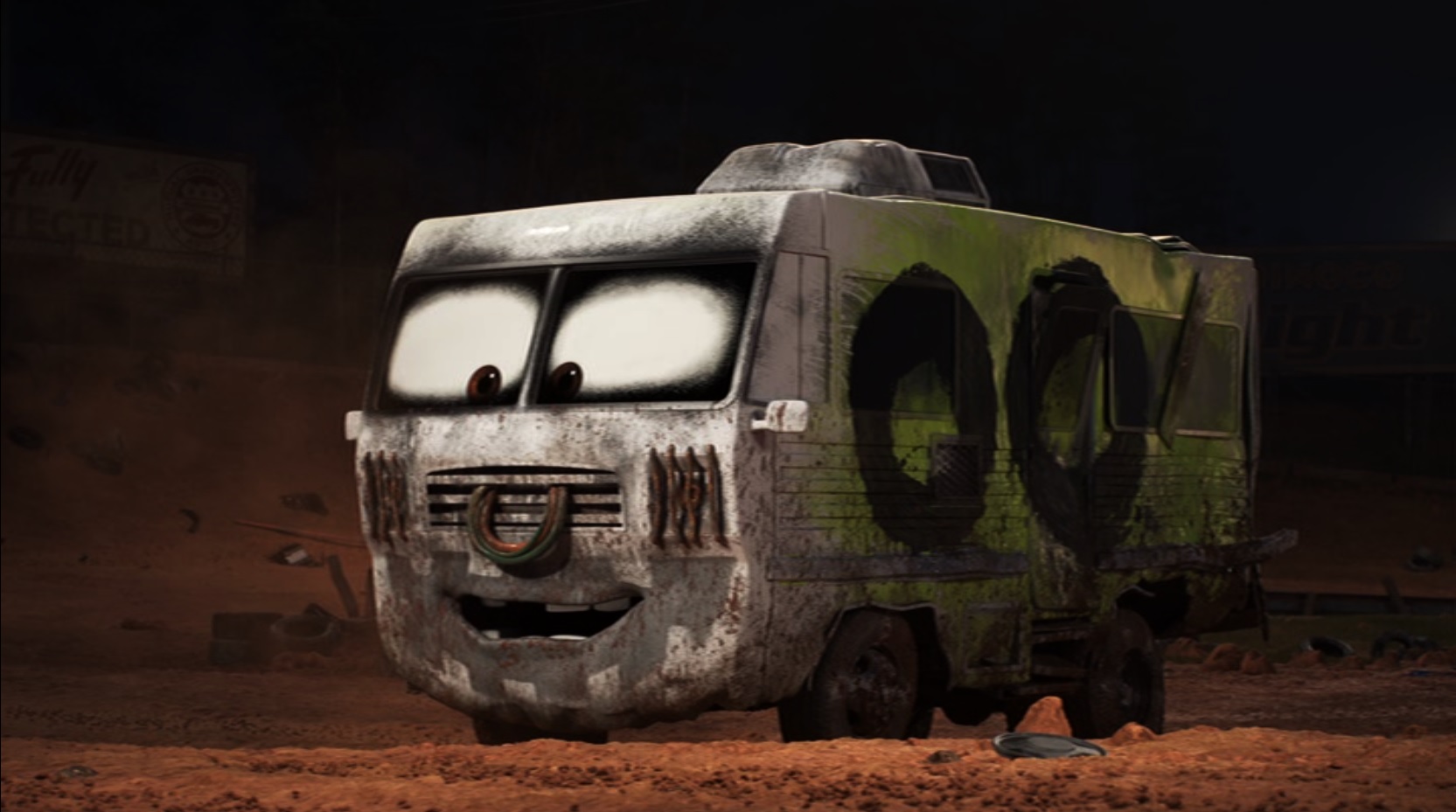
‘Miss Fritter’s Racing Skoool’ is short spin off short from ‘Cars 3‘ and present on the Blu-Ray/DVD of the movie.
The film is a short commercial by Miss Fritter, the modified school bus from ‘Cars 3’, featuring four cars stating how her school changed their lives, and with cars impersonating Lightning McQueen and Cruz Ramirez, with whom we are watching the add.
This short is nothing special, but it does entertain for its three minutes, although it is quickly forgotten afterwards.
Watch ‘Miss Fritter’s Racing Skoool’ yourself and tell me what you think:
‘Miss Fritter’s Racing Skoool’ is available on the Blu-Ray and DVD of ‘Cars 3’ and of the ‘Pixar Short Films Collection: Volume 3’
Director: Ivan Ivanov-Vano
Release date: 1969
Rating: ★★½
Review:

‘Seasons’ is a very poetic stop-motion film set to music by Pyotr Ilyich Tchaikovsky.
The film tells about two lovers through the seasons, although we see mostly images of autumn (the two riding together through a forest) and winter (a lengthy sleigh ride), with summer being reduced to a reminiscence of happier times, and spring hardly identifiable, at all.
The film is directed by Ivan Ivanov-Vano, but co-directed by Yuri Norstein, and already contains several elements of the later director’s mature style: the stop-motion is close to cut-out animation, there are plenty multi-plane effects, and the filming of the images has a soft, poetic edge to it. The designs are extraordinary beautiful, especially that of the crystalline forest, but as practically nothing happens during the entire film, the result is as enchanting as it is boring.
Watch ‘Seasons’ yourself and tell me what you think:
‘Seasons’ is available on the DVD ‘Masters of Russian Animation Volume 2’
Director: John Lasseter
Release date: June 24, 2011
Rating: ★★½
Review:

During the 2000s the Pixar studio without doubt was the leading American animation studio, pushing the envelope with classics like ‘Monsters, Inc.’ (2001), ‘Finding Nemo’ (2003), ‘The Incredibles’ (2004) and ‘Wall-E’ (2008). The 2010s, however, were a different affair, with the studio releasing a few disappointing originals (‘Brave’ from 2012 and ‘The Good Dinosaur’ from 2015), while regressing to a depressingly large number of sequels (seven out of eleven releases). Now, if they were all as good as ‘Toy Story 3’ (2010), then this would be a rather minor problem, but this is not a case.
‘Cars 2’ is the sad herald of the new era. Sure, the film knows high production values, boasting overwhelming visuals, fast cutting, professional cinematography, and storytelling, capable character animation etc. etc., but for the Pixar studio the film feels disappointingly unambitious and empty. Now, ‘Cars’ (2006) itself was the weakest feature of the 2000s, but commercially it was highly successful, not in the least in the merchandize area. So, it was a likely candidate for a sequel.
In retrospect, ‘Cars’ was a modest affair, with its rural setting. ‘Cars 2’on the other hand takes place all over the globe, with alternate versions of Tokyo, Paris, Italy (the fictive ‘Porto Corsa’) and London. These settings are highly colorful, but feel rather plastic and never become entirely convincing (for example, what’s the function of a Notre Dame in the Cars world? Even if a Pope Cars does exist as we can see in one of the scenes in Italy). The plot, too, is outrageously outlandish, modeled on the James Bond films and starring a British spy car called Finn McMissile (Michael Caine), who accidentally recruits Mater, whom he thinks is an American spy.
Thus ‘Cars 2’ is Mater’s film. There’s a minor subplot featuring Mater’s and Lightning McQueen’s friendship being put to the test, and indeed, this forms the rather shallow ‘heart’ of the film, and provides the film’s moral messages (e.g., by McQueen himself in the 84th minute), but this weakly developed plot cannot compete against the spy plot extravaganza. Mater blunders through the spy plot like a rather lame car version of Inspector Clouseau, but his knowledge of old cars does come in handy, and in the end Mater turns out to be less dimwitted than everybody thought.
Now, Mater is little more than comic relief, and one hardly relates to him, even if he’s more sympathetic than Lightning McQueen ever was (and McQueen certainly isn’t in this film). Unfortunately, Mater’s antics are rather tiresome, not funny, and the film’s focus on this shallow character certainly contributes to its feeling of emptiness. In fact, the film is at its best when sticking to the spy plot itself, with the cool spy car Finn McMissile and his female help Holley Shiftwell trying to uncover an evil plot involving one Professor Zündapp (with Erich von Stroheim-like monocle). The plot, like in most James Bond films, is rather outlandish and over-the-top, not to say highly improbable, but the film makers clearly enjoy the spy spectacle, enhanced by Michael Giacchino’s excellent spy movie score.
These scenes are given much more love than the original Cars characters. In fact, apart from Mater and McQueen the rest of the gang is hardly seen and they only marginally contribute to the plot (Doc Hudson apparently has died, just like his voice actor Paul Newman, who passed away in 2008). Instead, we, like McQueen, must endure a boasting Italian race car called Francesco Bernoulli (John Turturo) and meet a grandfatherly old Fiat 500 called uncle Topolino, which is both the nickname of that car model and Mickey Mouse’s Italian name.
Being rich in spectacle, but disappointing in the humor department, and lacking great characters, and most of all heart, ‘Cars 2’ is as entertaining as it is empty and forgettable. Even the small background puns (Towkyo, a Ratatouillan Paris restaurant called ‘Gustow’, adverts for Lassetyre) cannot save the film. Even worse, ‘Cars 2’ also introduces boats and planes with faces. This development would lead to the abysmal spin-off ‘Planes’ (2013), not by Pixar but by the Disneytoon Studios, a film that is an embarrassment to both Disney and Pixar. With the equally unnecessary ‘Cars 3’ Pixar would luckily return to more rewarding waters, with its ‘A Star Is Born’-like plot.
Watch the trailer for ‘Cars 2’ yourself and tell me what you think:
‘Cars 2’ is available on Blu-Ray and DVD
Directors: Joann Sfarr & Antoine Delesvaux
Release date: June 1, 2011
Rating: ★★½
Review:

‘Le chat du Rabbin’ is the film version of the comic strip series of the same name, which comprises eleven volumes thus far. At the time the film was made there were five albums, and the film retells the contents of volume one, two and five very faithfully, with a lot of panels and dialogue being transformed directly from comic strip drawings to film scenes.
Perhaps this is no wonder, as the comic’s author Joann Sfar co-directed the film. He must have had an important vote in the production, because the film flawlessly transcends Sfar’s idiosyncratic drawings to the animated screen
‘Le chat du rabbin’ is set in Algiers, the capital of Algeria, when it was still a French colony. It’s a little hard to date the time setting film, but because carbon dating is mentioned and because of the presence of jazz guitarist Django Reinhardt this limits the time period between 1947 and 1953. In Algiers, the French, Jews, and Muslims all live together harmoniously, and we follow a rabbi of the Sephardic community, and his cat, who turns into a talking creature after swallowing a parrot.
It’s the cat who is the narrator of the film, and we see the events often through his eyes, although, unfortunately, this isn’t maintained consequently. The scenes with the talking cat, mostly recreating the first book, are the film’s best, for the cat turns out to be a skeptic and he asks his master philosophical and theological questions, which are all valid, but drive the poor rabbi mad.
Unfortunately, not only the cat, but the whole movie is rather talkative, and far too dialogue rich, a problem all too common in all French cinema. But this is not the movie’s main problem. No, regrettably, the film also shares the many story problems of the original comic books. Sfar seems to have started his comic book series without a plan, and the volumes are highly different in tone and content. Story ideas are introduced and dropped, and there’s a frustrating lack of focus.
The same accounts for the film. For example, halfway the cat loses his speech again, and with the film immediately loses its main attraction. Even worse, the most interesting character of both the comic books and the film is Zlabya, the rabbi’s daughter, but she lacks a story arc, and is rarely seen, especially during the second half of the film, which focuses on the contents of volume five, in which the attention shifts to a far less interesting character of Russian origin in search of a mythical city of Jews somewhere in Ethiopia. With this part we also leave Algiers and all hope of a consistent story. I actually find the Russian’s quest utterly boring, and I wish the film makers dared to stay in Algiers and tell more about Zlabya. What certainly doesn’t help is an irritating and incomprehensible encounter with famous comic book character Tintin, who turns out to be a complete dork in this film.
The film’s designs are gorgeous, transferring Sfar’s sketchy comic book’s drawings very well, and applying very attractive color schemes, which evoke the subtropical, Mediterranean, and North African settings excellently. Especially the background art is gorgeous. Although heavily hatched, and thus very graphical, the animation reads very well against those background drawings, and it’s nice to see such a consistency of style from animated drawings to background art. There are even some very attractive Van Gogh influences visible in some of the night scenes.Olivier Davaud’s music, too, attributes to the Arabian atmosphere, with its quasi-Arabic style elements.
The animation, on the other hand, is not always that good. For example, when Zlabya plays the piano, the animation and the music aren’t in tune, at all. The animation is at its best when deviating from realism, as in the cat’s dream. In this dream sequence a bolder style is explored, with a lot of metamorphosis, absent from the rest of the film. The finale, too, explores a bolder style, just like the comic book does in these scenes, and I guess with this Sfar tries to tell us by then we’ve abandoned reality and entered the realm of tall tales. These scenes are certainly interesting to look at, but as said before, by then I at least had lost all interest already.
In all, ‘Le chat du Rabbin’ is a visually very attractive film, showing what traditional animation still can do in terms of original styling, but its rambling tale and its lack of focus make the film a frustrating watch. But to be honest, when reading the original comic strips one will experience the same frustration, thus the original source material is to blame. One wishes Sfar was as good a story teller as a visual artist, but let’s face it, he isn’t.
Watch the trailer for ‘Le chat du Rabbin’ yourself and tell me what you think:
‘Le chat du Rabbin’ is available on Blu-Ray and DVD
Director: Jeff McGrath
Airing Date: May 25, 1996
Stars: Duckman
Rating: ★★½
Review:
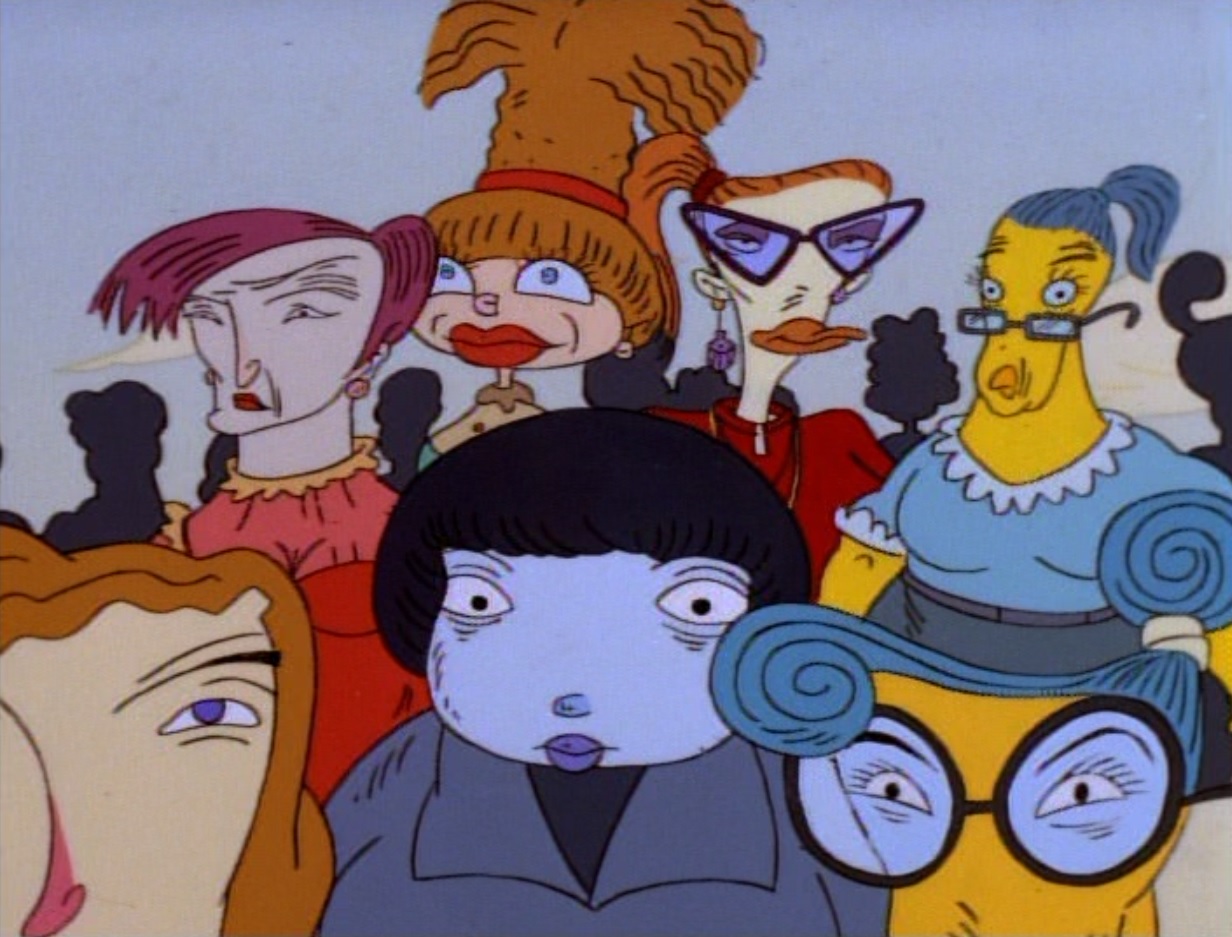
‘Exile in Guyville’ is another example of how the Duckman series started to run dry as the third season progressed.
This episode, which incidentally shares its title with a 1993 Liz Phair album, is framed as a story told as one of the Duckman fables Told by a mother to her son in the far future. The ‘fable’ itself is a rather forced and surprisingly stale fable on male-female relationships, drawing on almost every cliché one can possible find on men and women. When the nation divides literally, Fluffy and Uranus turn up as unlikely guards of the dividing wall.
The framing bedtime story has its charm, but the best part may be just before this divide when general mayhem is illustrated by e.g. some random live action footage. Nevertheless, these cannot rescue an episode that was already outdated when it first aired in 1996.
Watch ‘Exile in Guyville’ yourself and tell me what you think:
This is Duckman episode no. 39
To the previous Duckman episode: The Road to Dendron
To the next Duckman episode: The Longest Weekend
‘Exile in Guyville’ is available on the DVD-box ‘Duckman – The Complete Series’
Director: Peter Peake
Release Date: January 7, 1995
Rating: ★★½
Review:

‘Pib and Pog’ starts off as a typical cartoon for preschoolers. It stars two clay characters wearing shoes with flowers on them in a white set with only two props.
The two only make unintelligible sounds, but interact with the voice over (Ionna Wake), who retains an upbeat preschool attitude until the very end of the cartoon. But her remarks get more and more at odds with the visuals. For when Pib craves a shell that Pog apparently has found on the beach, a startlingly violent struggle between the two characters evolves, including the use of a gun, chloric acid and a cannon.
Meanwhile the voice over keeps on blabbering in a childish manner, neglecting the violence on the screen for what it is. ‘Pib & Pog’ thus is disturbing, and it seems to say something about cartoon violence in general, but funny it is not, and the short is further hampered by its very trite ending. Nevertheless, in 2006 the film would sprout five sequels. Earlier, in 1998 director Peter Peake would make a much better and certainly hilarious little film called ‘Humdrum’, which is much more recommended.
Watch ‘Pib and Pog’ yourself and tell me what you think:
‘Pib and Pog’ is available on the DVD ‘Aardman Classics’
Director: Donovan Cook
Airing Date: May 4, 1996
Stars: Duckman
Rating: ★★½
Review:

‘They Craved Duckman’s Brain!’ is one of the less inspired episodes that started to fill the third season more and more. This episode has a rather aimless and rambling story, which tries to say something about the medical industry, with little success.
The story features a mad surgeon called Dr. Craig Erlich and a frustratingly pointless villain. As this is one of the most talkative Duckman episodes, most of the humor comes from the dialogue. Like when Ajax asks Dr. Erlich after the latter’s introduction whether he’s related to Dr. Dre. The best gag in that respect is when the whole family starts an argument about Star Trek while being captured by the surgeon.
Note the painting in the director’s office, which looks like Gauguin’s ‘Spirit of the Dead Watching’, but with a white woman instead of a Polynesian one.
Watch ‘They Craved Duckman’s Brain!’ yourself and tell me what you think:
This is Duckman episode no. 37
To the previous Duckman episode: Aged Heat
To the next Duckman episode: The Road to Dendron
‘They Craved Duckman’s Brain!’ is available on the DVD-box ‘Duckman – The Complete Series’
Director: Peter Shin
Airing Date: March 16, 1996
Stars: Duckman
Rating: ★★★
Review:
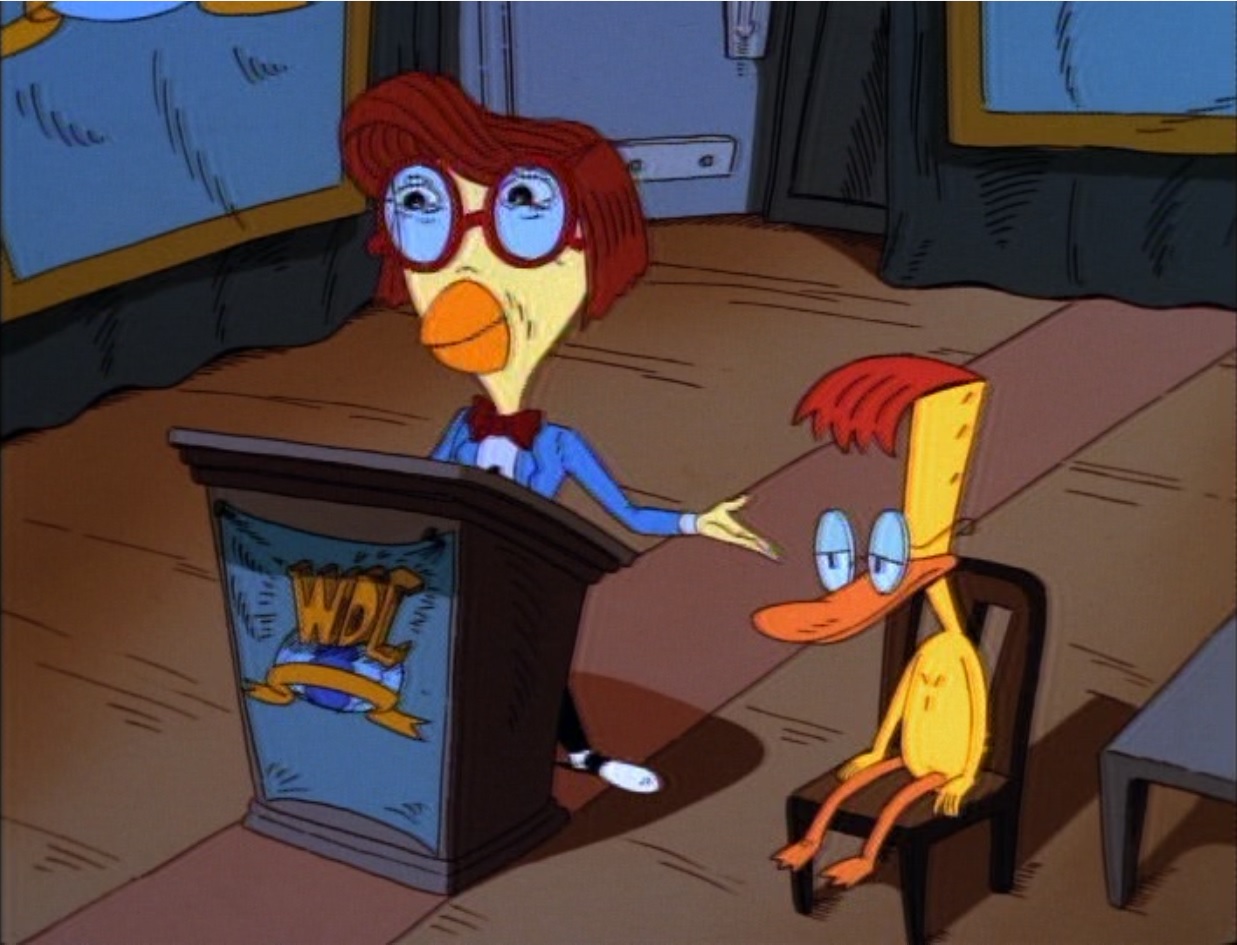
With a title as ‘The Mallardian Candidate’ (a nudge to the 1962 film ‘The Manchurian Candidate’) one needn’t wonder that this episode is about conspiracies.
This episode starts with the comedian Iggy Catalpa (see ‘Joking the Chicken‘ and ‘Color of Naught‘) asking Duckman for help in solving a conspiracy theory. Duckman is as clueless as ever, failing to identify criminals even when they surround them dropping clues all over the place. Soon he gets brainwashed and is turned into an automaton with a single killing purpose…
‘The Mallardian Candidate’ fails to play out the conspiracy concept very well. The best parts are Catalpa’s explanation of how his world domination organization works, and the very end of the episode, which in a few seconds shows what’s fundamentally wrong with the concept of conspiracy theories in the first place.
But mostly, the episode plays on Duckman’s mindlessness and uselessness. The parts involving his family are especially painful in that respect. In ‘The Mallardian Candidate’ Duckman is just a caricature, not the more complex persona he can be in other, better episodes.
Watch ‘The Mallardian Candidate’ yourself and tell me what you think:
This is Duckman episode no. 32
To the previous Duckman episode: The Girls of Route Canal
To the next Duckman episode: Pig Amok
‘The Mallardian Candidate’ is available on the DVD-box ‘Duckman – The Complete Series’
Director: Norton Virgien
Airing Date: January 20, 1996
Stars: Duckman
Rating: ★★½
Review:

‘Grandma-ma’s Flatulent Adventure’ for once centers on grandma-ma, the only taciturn member of the family.
After Duckman’s doomed day of caring duty for her, the family decides to take her to a nursing room. Duckman is taking her, but loses his car, with grandma-ma in it, on the way…
‘Grandma-ma’s Flatulent Adventure’ isn’t a very focused episode, and ties different story ideas rather loosely together. It seems to want to say something about our treatment of the elderly, but this is immediately diluted by the rather random nonsense filling the episode. In that respect Grandma-ma’s own adventure is a particular series of nonsensical events.
Highlight, however, is the brief episode in which the family visits three nursing homes, one all too conspicuously called ‘Soylent Green’. Nevertheless, the episode is more interesting for its outlandish staging, with its extreme camera angles and close-ups than for its content. All who are more interested in Duckman’s personal life are treated on some images of his wedding day with the currently deceased Beatrice.
Watch ‘Grandma-ma’s Flatulent Adventure’ yourself and tell me what you think:
This is Duckman episode no. 25
To the previous Duckman episode: Forbidden Fruit
To the next Duckman episode: Color of Naught
‘Grandma-ma’s Flatulent Adventure’ is available on the DVD-box ‘Duckman – The Complete Series’

